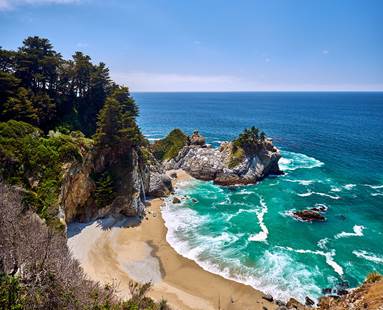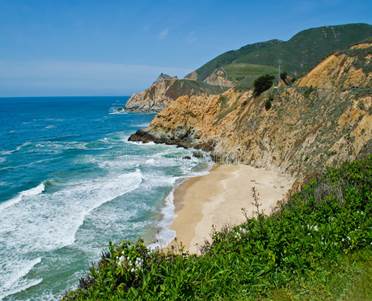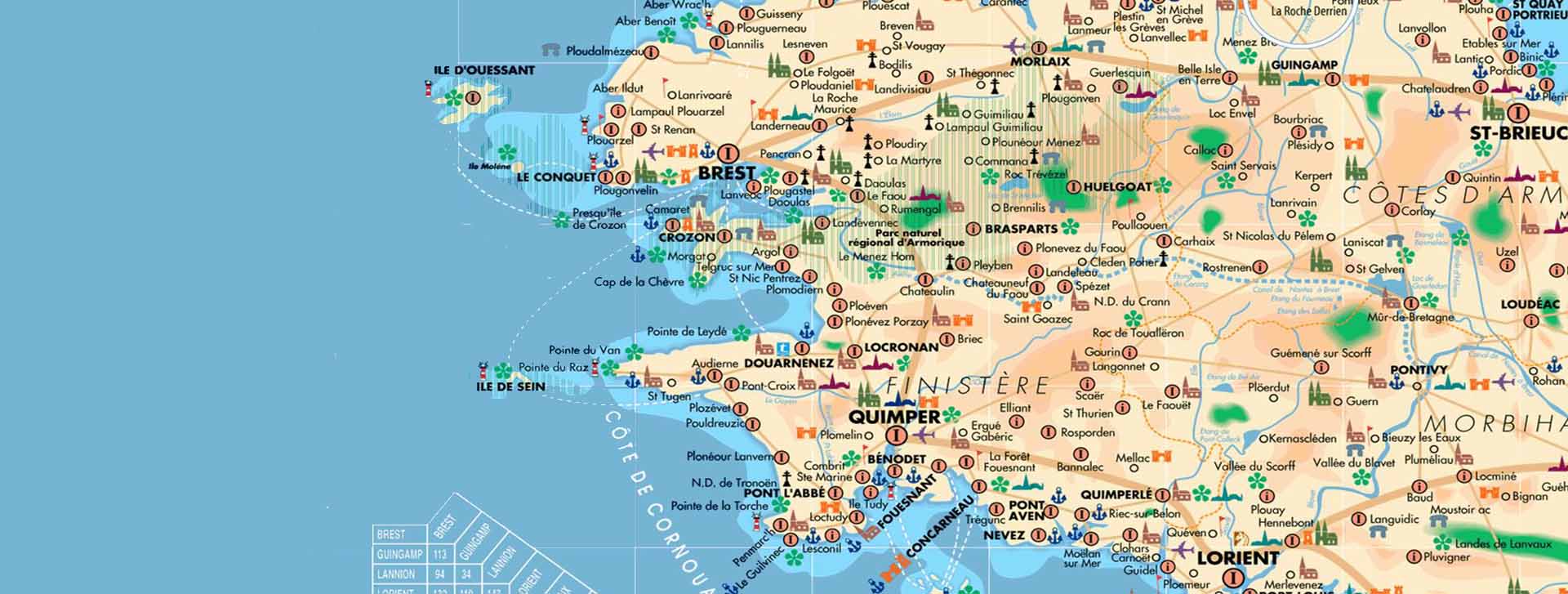Brittany Flag
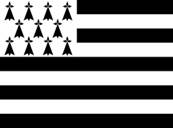 “Bretagne” in French, “Breizh” in Breton language is located in the North western part of France. Brittany is bounded by the régions of Normandy to the northeast and Pays de la Loire to the east. It protrudes westward into the Atlantic ocean as a peninsula. The Bay of Biscay lies to the southwest and the English Channel to the north. The capital is Rennes.
“Bretagne” in French, “Breizh” in Breton language is located in the North western part of France. Brittany is bounded by the régions of Normandy to the northeast and Pays de la Loire to the east. It protrudes westward into the Atlantic ocean as a peninsula. The Bay of Biscay lies to the southwest and the English Channel to the north. The capital is Rennes.
Region, France
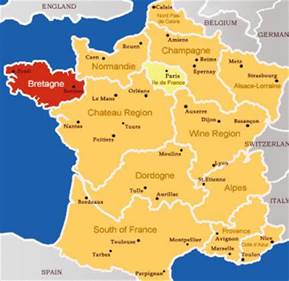

Crêpes (or “Krampouz” in beton language) are essential to the people of Brittany. When made in the northern part of Brittany, the savory crêpes are called “galettes” and are made with 100% buckwheat flour (“Cote d’Armor” & “Ile et Vilaine”). In the other areas of Brittany (center and southern part), savory crêpes are called “crêpe a l’eau” (crêpe made with water) and the sweet ones are called “crêpe au lait” (crêpe made with milk). In those areas, the buckwheat is mixed with some regular wheat flour, in various proportion depending on the area or town that they are made. At Crêpes of Brittany, we are using a recipe that is commonly used in the town of “Gourin” in the center of Brittany (25 miles northeast of Quimper).

“Gourin” is known in Brittany for being the origin of many immigrants to United States and Canada during the first part of the 20th century. It has a large bronze replica of the Statue of Liberty standing in the main square by the town hall.
Gourin still has a large number of native Breton speakers. The people of this region are very proud of their Celtic heritage and have preserved many old customs and traditions. 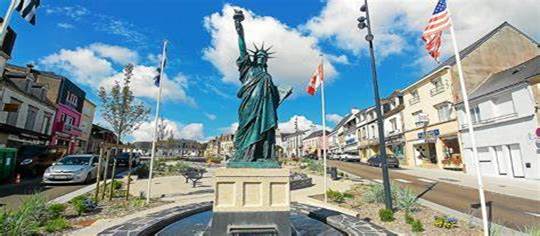
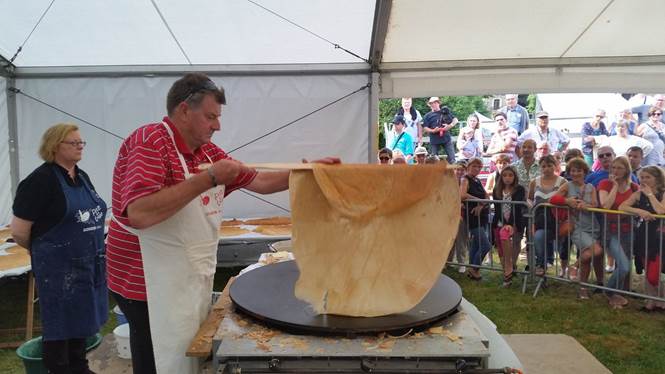
On the last weekend in July, there’s a Crêpe Festival in Gourin, a ‘Krampouz Party’ attended by food lovers and other spectators and involving a competition for the world’s largest crêpe and the best crepe maker in town. Most crepe specialists will admit , Gourin is where you find the best crepes anywhere, worldwide. The festival is a way to celebrate that, enjoy it!
Celtic influence
The beauty of Brittany attracts many travelers, transporting them into a world of mysticism and legends. Here are some little-known facts about Brittany's Celtic roots:
- The Celts originally came from the steppes of Central Europe, but began migrating West towards the Atlantic
- The historic "Gaulois" people of France are actually Celts who migrated and stayed in France
- The word Celtae or Galates means "invader" in Latin, and it later became Gallie and finally Gaulois
- The Celts fled from France following the Roman invasions
- From the 5th century AD, a group of Briton people returned from Great Britain in order to flee their invaded homeland, settling in the Armorican Peninsula (what is now "Brittany")
- Many Celtic dialects were lost throughout history, however Breton, Welsh, Scottish, and Irish are still spoken today.
- Today Brittany is one of the 6 official Celtic nations of the world. Others include, Ireland, Scotland, Wales, Cornwall, and the Isle of Man
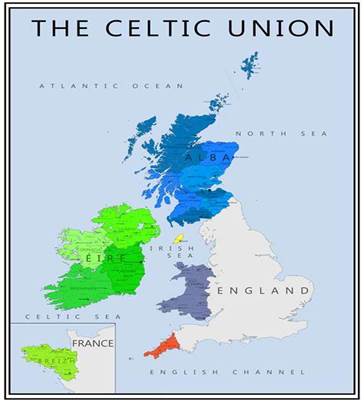
The region has held fast to its Celtic history, meaning a strong culture separates it from the rest of France. It’s truly unique and offers some of the best food, music, culture and countryside in France.
Crêpes are essential to people of Brittany. “Crêperies” outnumber cafés. It is traditional to eat crêpes with hard apple cider. Brittany and Normandy are not wine region but the soil and climate is perfect for growing apples, that’s why those region have a well established apple culture.
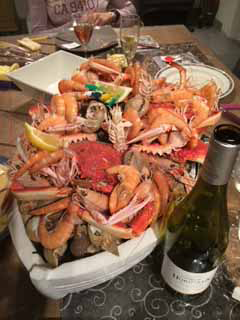
Seafood, With its important coastline, Brittany is definitely a mecca for lovers of shellfishes, from the delicious oysters from Cancale to the fine scallops from Erquy. Brittany Fishes and Seafood are some jewels of the French gastronomy and make this lovely, traditional region of France a favorite destination for both French and foreign tourists.
Sardines: Brittany is where the canning of these little delicacies
began. In 1836 over 30,000 tins of sardines from Brittany were sold throughout the world and France became the leader in tinned-sardine sales.
Biscuits and caramels: Thanks to the importance and the violence of the tides in Brittany, high quality salt is produce in the region. The dairy is also well developed and Brittany is famous for its large variety of dairy products. Brittany is also well known for its biscuits, Galettes, made with plenty of fresh butter and natural salt, as well as for its cream of salted butter caramel, using salt specially produced in Guérande. Those recipes passed down from generation to generation, maintain the simple taste of the tradition.
salt, as well as for its cream of salted butter caramel, using salt specially produced in Guérande. Those recipes passed down from generation to generation, maintain the simple taste of the tradition.
Crêpe dentelle : In 1886, when a crêpe maker forgot to take a crepe off the griddle she rolled up the crispy crêpe and invented the crêpe dentelle. This delicate snack requires that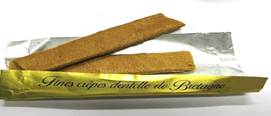 the crepe is rolled up 8 times
the crepe is rolled up 8 times
.
Culture: The culture of Brittany’s made up of Breton culture, Everyday versions are less varied, although some are decorated according to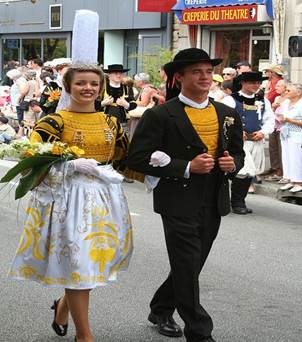 profession or location. The women wear long dresses with white aprons, lace collars with lace headdresses. And men wear a white shirt with black trousers along with a close-fitting vest. The distinctive Breton costume is deeply associated with their culture. In the early 20th century there were said to be nearly 800 different types of the Breton lace headdress.
profession or location. The women wear long dresses with white aprons, lace collars with lace headdresses. And men wear a white shirt with black trousers along with a close-fitting vest. The distinctive Breton costume is deeply associated with their culture. In the early 20th century there were said to be nearly 800 different types of the Breton lace headdress.
Since the late twentieth century the traditional dress is almost always worn during special religious events and cultural events involving Celtic Circles leading to the "Breton costume" becoming "folk costume" of the region.
Striped shirt: Breton striped jerseys were introduced as the official French Navy uniform in 1858. French stripes have since influenced fashion trends all over the world. This kind of striped garment is often part of the stereotypical image of a French person. It is also known as a Breton shirt, as many sailors in the French Navy were from Brittany.
Brittany’s Handicraft:
Quimper is a city located in the Bretagne region, France. The castle walls built in the Middle Ages and the rows of sturdy old houses are a constant reminder of the strength of history and culture in the region. 
The 30 year old tradition of Quimper ceramics is famous worldwide, as generation after generation of skilled traditional artists have continued to produce the traditional patterns featuring the Breton figures as well as many new more modern designs.
Brittany Coast :
Brittany coast has the largest concentration of lighthouses in the world, with a record in Finistère.,
(The name Finistère derives from the Latin Finis Terræ, meaning end of the earth). The waters off Brittany's west coast still remain one of the most dangerous seas in Europe with frequent violent storms, huge waves and strong currents.
A photograph of a big wave hitting a lighthouse has been making the rounds on the internet for a number of years. The picture appears to show a lighthouse keeper in a doorway as the water crashes into the opposite side of the structure. It was captured by photographer Jean Guichard from a helicopter on Dec. 21, 1989.
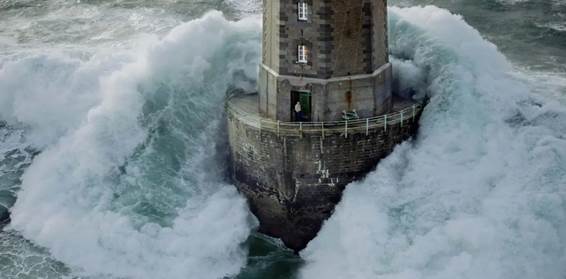
Brittany has an amazing 1700 miles of glorious coastline (longer then the distance between Seattle and San Diego) In parts dramatic towering cliffs and rugged rock formations creating some of the most spectacular coastal scenery in France.
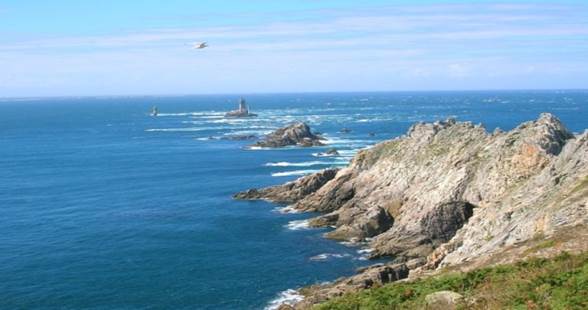 Raz Point marks the western end of the 3,200 km european long distance path to Venice in Italy. Many travelers will agreed, the coastline of Brittany has a lot of similarity with California coastline…
Raz Point marks the western end of the 3,200 km european long distance path to Venice in Italy. Many travelers will agreed, the coastline of Brittany has a lot of similarity with California coastline…
Brittany Coastline


California coastline